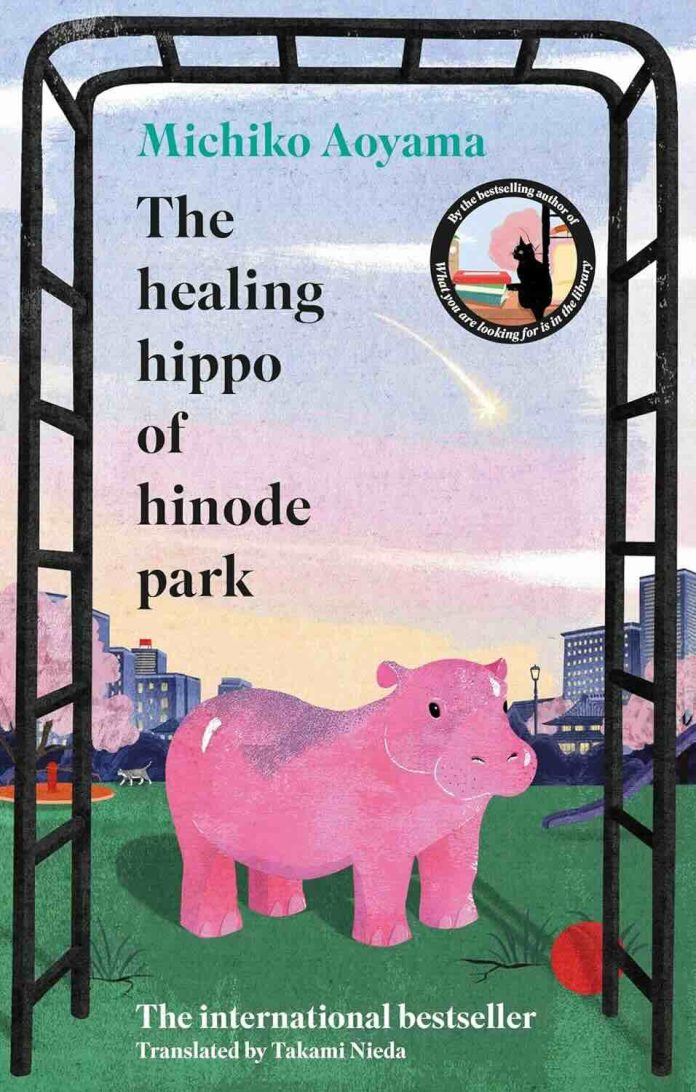In the shadow of a modest five-story apartment building called Advance Hill, nestled within the unassuming confines of Hinode Park, sits an unlikely beacon of hope. Kabahiko, a paint-chipped orange hippo ride with tearful eyes and a perpetual smile, becomes the silent confidant to five disparate souls seeking healing in Michiko Aoyama’s latest offering, The Healing Hippo of Hinode Park. This gentle exploration of human vulnerability and community connection serves as a worthy successor to her internationally acclaimed What You Are Looking For Is in the Library, though it treads a more intimate path through the geography of personal pain.
Aoyama crafts a narrative that feels both uniquely Japanese and universally resonant, where the ordinary becomes extraordinary through the simple act of believing—or perhaps more accurately, through the desperate need to believe. The hippo itself, with its peeling paint and weathered features, serves as a metaphor for the residents themselves: scarred by time and circumstance, yet maintaining an essential dignity and capacity for connection.
Five Stories, One Shared Sanctuary
The novel unfolds through five interconnected vignettes, each focused on a different resident of Advance Hill who finds their way to Kabahiko’s healing presence. Kanato, a high school student grappling with academic failure and wounded pride, begins the collection by touching the hippo’s head, hoping to restore his intelligence. His story establishes the book’s central theme: the gap between who we believe ourselves to be and the reality we must eventually confront.
Sawa, a mother struggling with her identity within a competitive parent group, seeks healing for her mouth—her ability to communicate authentically rather than merely please others. Her narrative explores the exhausting performance of social conformity and the courage required to speak one’s truth. Aoyama demonstrates particular skill in depicting the subtle cruelties of modern parenting culture, where every interaction becomes a potential battlefield for status and belonging.
Perhaps the most poignant story belongs to Chiharu, a young wedding planner suffering from a stress-induced ear condition that makes her own voice echo painfully in her head. Her physical ailment becomes a powerful metaphor for the way heartbreak and disappointment can literally make us sick, trapping us within our own suffering. The author handles her romantic disappointment with remarkable sensitivity, avoiding melodrama while acknowledging the very real pain of unrequited love.
The Architecture of Healing
Aoyama’s greatest strength lies in her ability to find profound meaning in mundane moments. The simple act of touching a playground animal becomes a ritual of hope, a physical manifestation of the human need to believe in something beyond our immediate circumstances. The hippo serves not as a magical cure but as a catalyst for self-reflection and eventual action.
The author’s prose, expertly translated by Takami Nieda, maintains the delicate balance between simplicity and depth that characterized her previous work. There’s a meditative quality to the writing that mirrors the contemplative nature of the characters’ visits to Kabahiko. Each touch of the hippo becomes a moment of pause, a breathing space in lives otherwise consumed by anxiety and obligation.
The community aspect of the narrative deserves particular attention. While each character initially approaches Kabahiko in isolation, their stories gradually interweave, revealing the invisible threads that connect neighbors in modern urban life. The elderly woman who runs Sunrise Cleaning emerges as an unlikely sage, dispensing wisdom alongside honey candies and perpetuating the legend of Healing Kabahiko.
Subtle Critiques Within Gentle Storytelling
While The Healing Hippo of Hinode Park operates primarily as a comfort read, Aoyama doesn’t shy away from social commentary. The academic pressure faced by Kanato reflects broader concerns about Japan’s educational system, while Sawa’s experience highlights the isolating nature of contemporary motherhood. Chiharu’s workplace stress speaks to the particular challenges faced by young women in professional environments.
However, this social awareness occasionally feels underdeveloped. The book’s commitment to gentle resolution sometimes prevents deeper exploration of systemic issues. The characters’ problems are largely resolved through personal growth and community support, which, while uplifting, may feel simplistic when considered against the broader structural challenges they face.
The pacing also presents some challenges. While the deliberate, contemplative rhythm suits the overall tone, certain sections—particularly in the middle stories—feel somewhat static. The healing process, by its nature, requires time and patience, but this can translate into narrative moments that lack dynamic tension.
Translation and Cultural Bridge-Building
Takami Nieda’s translation deserves recognition for preserving both the linguistic subtlety and cultural specificity of Aoyama’s original text. The Japanese concept of ikigai—life’s purpose—permeates the narrative without being explicitly named, while the importance of community harmony and mutual support feels authentic rather than explanatory. The translation successfully conveys the particular Japanese sensibility toward healing and wellness, where mind, body, and community are understood as interconnected.
The urban setting of contemporary Tokyo suburbs is rendered with careful attention to detail, from the convenience store culture to the complex social dynamics of parent groups. These elements provide Western readers with insight into modern Japanese life while maintaining the story’s universal themes of loneliness, aspiration, and connection.
Literary Context and Comparative Analysis
The Healing Hippo of Hinode Park exists within a tradition of Japanese literature that finds the extraordinary within the ordinary. While it lacks the philosophical depth of authors like Haruki Murakami or the psychological complexity of Yoko Ogawa, it offers something equally valuable: accessible wisdom delivered without pretension.
The book shares DNA with contemporary works exploring community and healing, including:
- “A Man Called Ove” by Fredrik Backman – Healing through unexpected connections
- “The Midnight Library” by Matt Haig – Personal transformation through alternative perspectives
- “Klara and the Sun” by Kazuo Ishiguro – Hope and healing through non-human perspective
Minor Missteps in a Gentle Journey
The book’s commitment to wholesomeness occasionally veers toward the saccharine. Some character revelations feel telegraphed, and the resolution of certain conflicts happens perhaps too easily. The symbol of the hippo, while charming, occasionally bears more metaphorical weight than it can comfortably carry.
Additionally, the interconnections between characters, while satisfying, sometimes feel overly convenient. The small world of Advance Hill requires significant suspension of disbelief regarding the likelihood of such meaningful coincidences.
A Worthwhile Addition to Comfort Literature
Despite these minor criticisms, The Healing Hippo of Hinode Park succeeds as both comfort reading and genuine literary exploration of human resilience. Aoyama has created a work that acknowledges pain while maintaining faith in the possibility of healing—not through magic, but through the simple yet profound acts of reaching out, listening, and caring for one another.
The book serves as a gentle reminder that healing often comes not from dramatic transformation but from small, repeated acts of courage and connection. In a world increasingly defined by division and isolation, Kabahiko’s silent presence offers a model for the kind of non-judgmental support we all need.
Full Disclosure
I received an advance reader copy of this book through a serendipitous encounter via email, much like how Aoyama’s characters stumble upon Kabahiko when they need him most. This review represents my honest assessment, colored perhaps by the same hope for healing that draws each character to that weathered orange hippo in the park.





